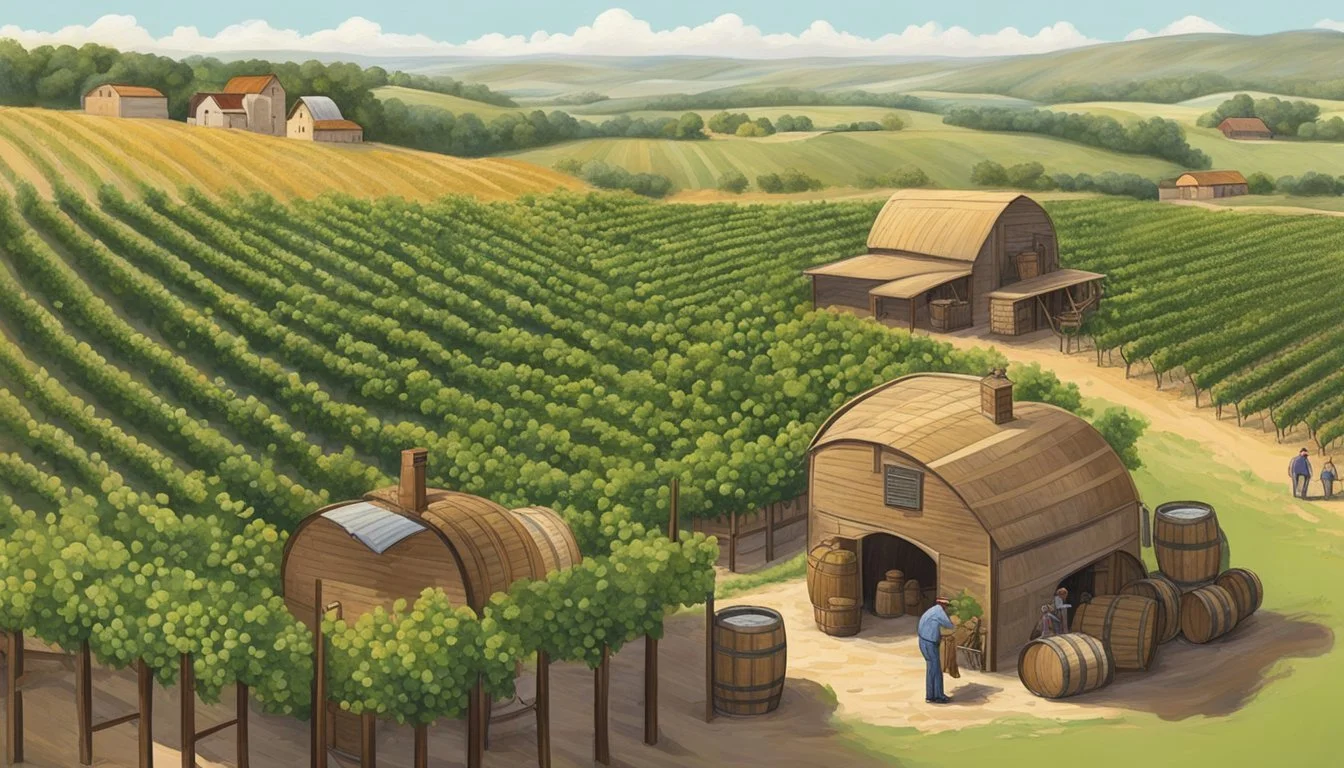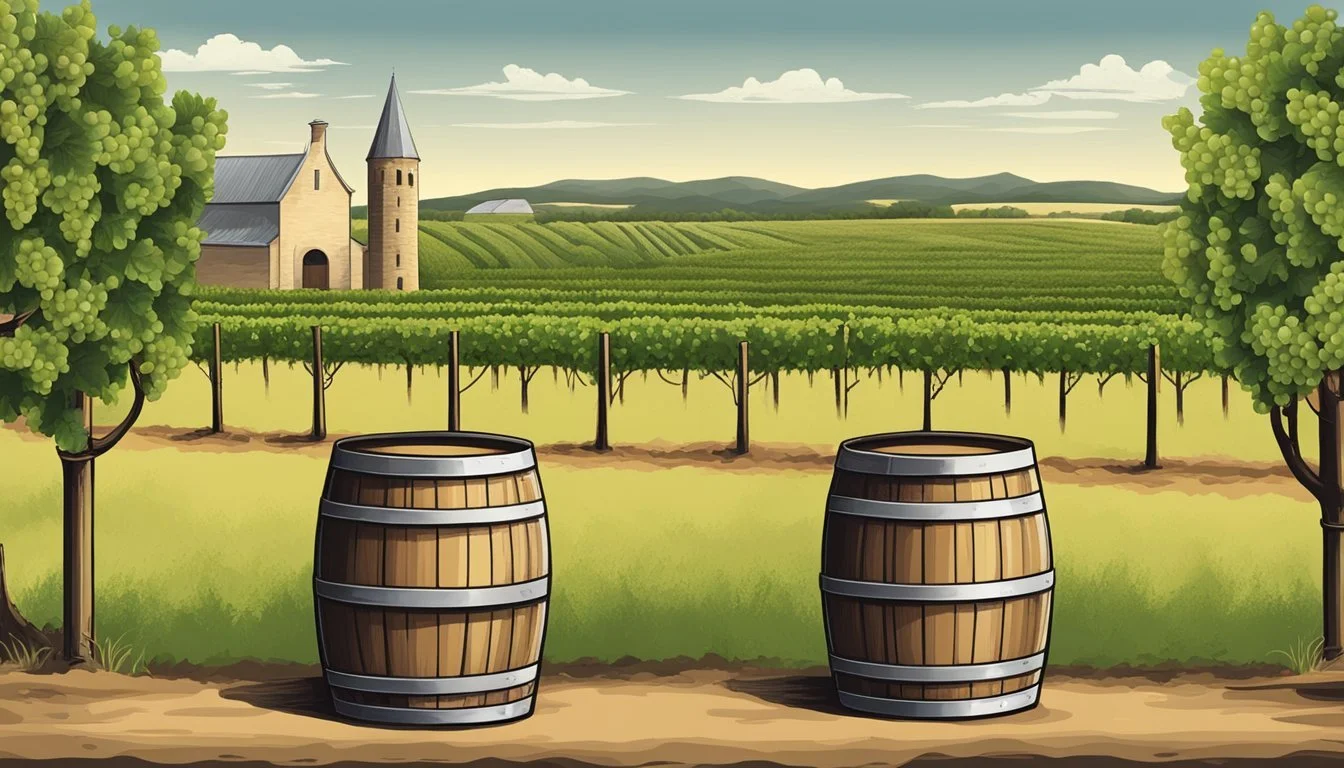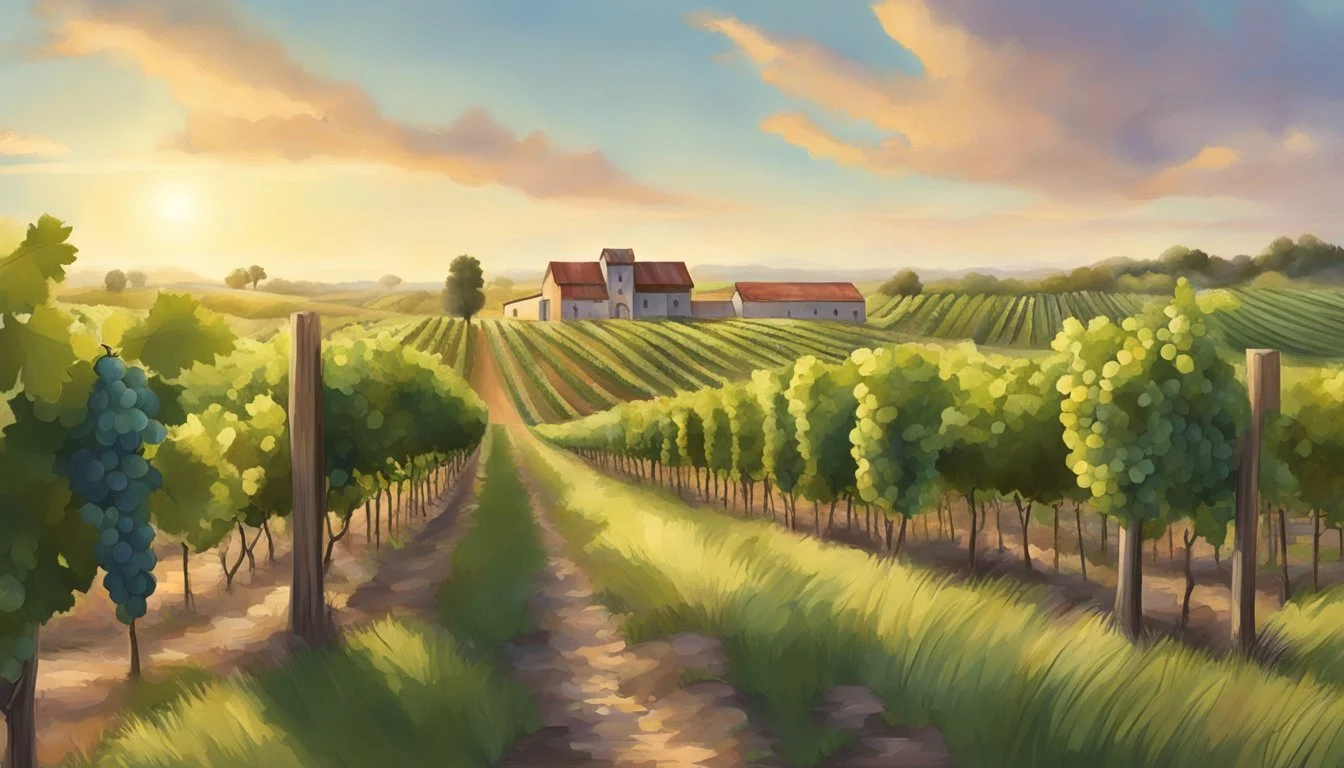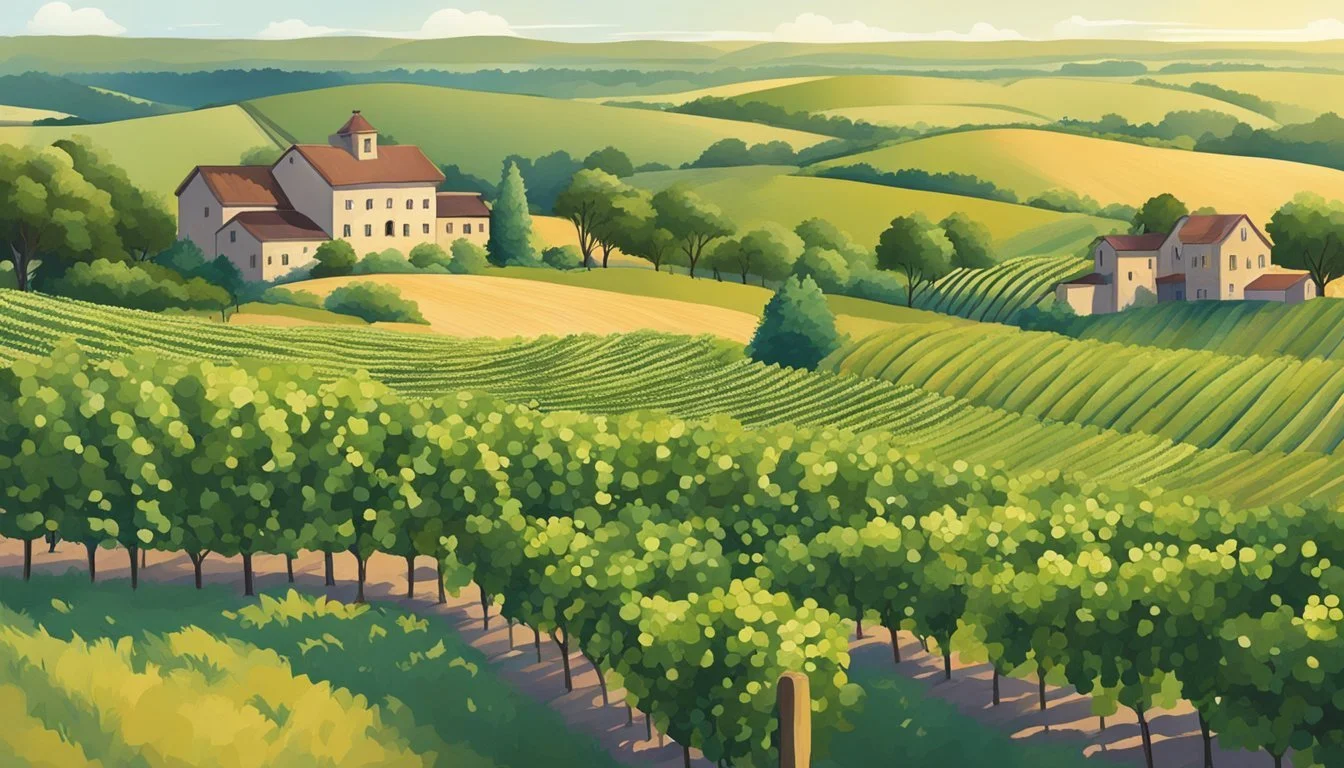The German Influence on Texas Wine Production
Historical and Modern Perspectives
The history of Texas wine is influenced significantly by German immigrants who settled in the central region of Texas, bringing with them their traditions of viticulture and winemaking. In the mid-to-late 19th century, these settlers began cultivating local grape varieties alongside European varietals, adapting their old-world knowledge to the unique terroir of Texas. Their expertise played a pivotal role in the establishment of a burgeoning wine culture within the state, which now proudly claims over 400 wineries.
The Texas wine industry, currently recognized as the fifth-largest in the United States, owes a great deal to the contributions of these early German vintners. Their understanding of the wine production process and the importance of matching grape varieties with the appropriate climate and soil has informed modern practices. This German heritage is evident in the Hill Country, where wineries continue to honor those traditional techniques, adjusted for the region's specific environment.
In the present day, the legacy of the German influence persists, evident in the commitment to quality and the growing acclaim of Texas wines on the national stage. The Texas wine industry, while it looks forward with innovation and an embrace of newer technologies, still values the foundation laid by those early German pioneers of the Texas wine story.
History of Texas Winemaking
Texas winemaking has a long and varied heritage, deeply influenced by Spanish missionaries and challenged by Prohibition. Its remarkable revival is a testament to the resilience and growth of an industry that thrives in a state often likened to the great wine-producing regions of Europe.
Spanish Missionaries and Early Beginnings
Spanish missionaries were instrumental in the origins of Texas wine, planting the first vineyards in the 1600s. They recognized the potential in Texas's warm climate and fertile soils for cultivating Vitis vinifera, the European grape species. This early involvement laid a foundation for a wine-producing tradition that has endured for centuries.
Prohibition and Its Impact
The onset of Prohibition in 1920 had a devastating effect on winemaking in Texas. Vineyards were abandoned, and the knowledge of viticulture nearly vanished. However, Thomas Volney Munson's work in developing grape rootstocks that were resistant to Phylloxera—a pest that destroyed many European vineyards—highlighted Texas's contribution to saving the global wine industry during this challenging period.
The Revival and Growth of the Texas Wine Industry
The modern Texas wine industry began to re-emerge in the 1970s, long after the repeal of Prohibition. Winemakers started rediscovering the state's grape-growing potential, leading to an increased number of wineries and vineyards. Texas is now the fifth-largest wine-producing state in the U.S., boasting over 400 wineries and expanding vineyards across 9,000 acres. The industry continues to build upon the pioneering efforts of those who recognized Texas's winemaking potential, marking its place on the global wine map.
Geographical Influence on Texas Wines
The geography of Texas profoundly shapes its wine production, with diverse American Viticultural Areas, unique soil compositions, and varying microclimates contributing to the distinct terroir seen across the state's vineyards.
American Viticultural Areas in Texas
Texas boasts eight American Viticultural Areas (AVAs), of which the most recognized are the Texas Hill Country AVA and the Texas High Plains AVA. Texas Hill Country, encompassing over 9 million acres, is the second-largest AVA in the nation. It is renowned for its picturesque landscapes and ideal winegrowing conditions. The Texas High Plains AVA, on the other hand, located on the high plains of the Llano Estacado, is known for its elevation and flat terrain, characteristics that facilitate consistent grape quality and maturation.
Clay, Limestone, and Unique Soils
Soil composition is a critical element in the terroir of Texan wines. The soils are as diverse as the state itself, ranging from the red sandy loam of the High Plains to the rich clay found throughout other parts of the state. In many Texas regions, notably Texas Hill Country, limestone is prevalent, imparting a mineral quality to the grapes that is often compared to the terroir of French wine regions.
Texas Hill Country: Limestone-based soil, contributing to minerality.
Texas High Plains: Sandy loam and clay, aiding water retention and root depth.
Microclimates and Texas Terroir
Microclimates across Texas have a significant impact on the expression of terroir in wine production. The state's size leads to a wide range of weather patterns, from the cooler temperatures in the Davis Mountains to the warmer, more humid climate of South-East Texas. These microclimates allow for a broad diversity of grape varieties to thrive. Texas vineyards capitalize on these microclimates, using them to cultivate grapes with unique flavor profiles that reflect the local terroir.
Texas Davis Mountains: Cooler climate, higher elevation affecting grape acidity.
Hill Country AVA: Varied microclimates, influencing ripening periods and flavor development.
Grapes and Varietals
In Texas wine production, the selection of grape varieties and the adaptation of these varietals play a critical role in the cultivation of quality wines that showcase the state's diverse terroir.
Vitis Vinifera and Native Varieties
Texas viticulture includes a blend of Vitis vinifera, the classic European wine grape species, and hardy native grape varieties. Vitis vinifera includes well-known grapes such as Cabernet Sauvignon and Merlot, while native species like the Mustang grape bear witness to the state's capacity to cultivate unique local varietals that contribute to the wine industry's regional character.
Popular Grape Varieties in Texas
Tempranillo and Viognier have emerged as signature grapes in Texas, reflecting the state's ability to grow varietals that thrive in its warm climate. Other popular varieties include:
Reds:
Mourvèdre
Sangiovese
Syrah
Malbec
Tannat
Whites:
Chenin Blanc
Chardonnay
Riesling
Roussanne
Sauvignon Blanc
The experimentation with grape varietals such as Grenache, Cinsault, and Ruby Cabernet highlights the evolving palate of Texas wine producers.
Grafting and Grapevine Adaptation
The menace of phylloxera, an insect that devastated many vineyards, necessitated the adoption of grafting techniques. By grafting European Vitis vinifera onto resistant native rootstock, Texas growers have successfully adapted European grapevines to local conditions. This practice has expanded the types of grapes that can be cultivated, enhancing both the complexity and the variety of Texas wines.
Winemaking in Texas
The winemaking process in Texas is marked by a dedication to quality and a blend of traditional and modern techniques. The state's diverse climates and soils, alongside innovations in viticulture and enology, have positioned Texas as a notable player in American wine production.
From Vine to Wine: The Production Process
Texas winemakers start with a variety of grapes suited to the state's microclimates, with a focus on sustainable vineyard practices. Vinification in Texas follows:
Harvesting: Grapes are picked at peak ripeness, with sugar, acid, and tannin levels considered for each variety.
Crushing and Pressing: Grapes are crushed gently and pressed to extract juice, with reds fermented with skins and whites without.
Fermentation: Yeasts convert grape sugars into alcohol; temperature-controlled tanks ensure consistent fermentations.
Malolactic Fermentation: Often employed to soften acidity in reds and some whites.
Innovation and Techniques
Texas winemakers employ cutting-edge enological techniques to enhance quality:
Temperature Control: Advanced systems manage fermentation temperatures to retain flavor and aroma profiles.
Micro-Oxygenation: Used to mimic the effects of barrel aging, giving wines more complexity.
Precision Viticulture: Modern practices such as soil moisture sensors and aerial imaging to manage vine health.
Aged to Perfection: Storage and Aging
Aging Texas wine is both science and art:
Barrel Aging: Oak barrels impart subtle flavors; the choice of French, American, or other oak types affects the end profile.
Bottle Aging: Proper storage conditions are crucial for aging potential; Texas winemakers recommend specific temperatures and humidity levels.
The Business of Wine in Texas
The Texas wine industry has become a significant player in the state's economy, contributing through winery operations, tourism, and regulatory support. This section explores the business aspects and the dynamic growth of viticulture in Texas.
Wineries and Economic Impact
Texas boasts over 400 wineries, with Texas Hill Country being one of the most prolific regions contributing to the American wine landscape. Notable wineries like Messina Hof and Becker Vineyards have played important roles in both local and state economies. Llano Estacado Winery, the Texas wine industry pioneer, along with newer entities like Escondido Valley and Val Verde Winery, support local communities through job creation and agricultural development. The economic impact is multifaceted, from vineyard labor to sales professionals, indicating a thriving industry.
Example:
Messina Hof: Established winery contributing to regional growth
Llano Estacado Winery: A pioneering entity supporting local economies
Tourism and Wine Festivals
The Texas wine industry significantly benefits from tourism, with wine festivals and wine-related events playing a crucial role in attracting visitors. The Texas Hill Country, for instance, is a major draw for wine enthusiasts, making it one of the most visited wine regions in the United States. Wineries often host tours and tastings, fostering an environment where wine culture can thrive and augmenting the state's tourism appeal.
Key Festivals:
Texas Hill Country Wine and Food Festival: Celebrates local wines
Harvest Wine Trail: Hosted by Texas Hill Country Wineries, drawing in tourists
Regulatory Environment and Support by Educational Institutions
Institutions like Texas Tech University and Texas A&M AgriLife offer vital research and educational support, which helps maintain a conducive regulatory environment for wine production. Texas Tech University, with a history connected to the state's wine beginnings, continues to be involved in viticultural research, while Texas A&M AgriLife provides extension services and specialized programs aimed at industry enhancement.
Educational Contributions:
Texas Tech University: Research that has historically supported the Texas wine industry
Texas A&M AgriLife: Offers programs and services to aid industry players
Comparative Analysis
This section dissects the interplay between Texas winemaking practices and German influences, contrasting them with the iconic wine regions of California and France, and contextualizes Texas's positioning within the global wine scene.
Texas versus California and France
Texas's wine industry, though young when compared to the legacies of California's Napa Valley and France's storied wine regions, shows a notable German impact. German settlers in the 1800s brought a winemaking tradition to the area, particularly influencing the Texas Hill Country AVA (American Viticultural Area).
California
Dominated by global giants
Famed for full-bodied wines, especially from Napa Valley
France
Epitome of old-world winemaking
Noted for its traditional European grape varieties
Texas, in contrast, is carving out a niche with varietals that mirror those from German wine regions, adapting to the local climate which differs significantly from California's Mediterranean climate and France's various terroirs.
Aspect California France Texas Climate Mediterranean Variable (oceanic to continental) Continental Grape Varieties Cabernet, Chardonnay Pinot Noir, Chardonnay Tempranillo, Viognier German Influence Minimal Historical competition Significant
Texas and the Global Wine Scene
Texas's wine contributions stand out in the global wine scene with its distinctive blending of German viticultural methods and the state's unique terroir. While not yet as prominent as California or France on the global stage, Texas winemakers utilize a combination of innovation and tradition to elevate their international profile.
Globally, the wine industry is vast and varied, with regions like California and France established as benchmarks. Texas joins the global conversation by offering unique wine profiles, including those with a German heritage that stands out against international competition.
Region Global Position Notable Characteristics California Leading producer, high international visibility Innovation, premium branding France Benchmark of quality, varied appellations Tradition, diversity of wine styles Texas Emerging presence, unique regional offering German influence, adaptability
Texas continues to grow its reputation, reflecting a synthesis of German-influenced winemaking within a Texan context – a testament to the state's potential on the wine world stage.
Cultural and Community Aspects
The German influence on Texas wine production is deeply interwoven with both the cultural identity of the state and its community dynamics. Here, wine production is not only an economic activity but also a symbol of cultural heritage and local involvement.
Wine in Texan Culture
In Texas, wine has become a significant part of the local culture, especially in areas such as Fredericksburg, where German heritage runs deep. This can be observed in:
Fredericksburg: Home to numerous vineyards and tasting rooms, reflecting the town's German roots through locally produced wines.
Wine Festivals: Celebrations such as Wurstfest in New Braunfels and local wine events in North Texas proudly showcase the state's wine alongside German cultural traditions.
Texan winemakers, many of whom draw on German viticulture knowledge, contribute to the identity and diversity of communities like Austin, Dallas, and San Antonio, blending the old world with the new.
Involvement in Local Communities
The Texas wine industry plays a pivotal role in bringing together various local communities, with a presence in rural and urban settings including:
Val Verde: A historical winery that acts as a cornerstone for community identity in Del Rio.
Texoma: Where small wineries foster close-knit relationships amongst locals.
Additionally, wine-related events in major cities such as Houston and El Paso stimulate urban economies and encourage community interactions. The industry's growth in Texas also contributes to the collaborative spirit among winemakers and wine enthusiasts alike.
Local wineries actively engage with their communities by:
Providing employment opportunities and contributing to local economies.
Hosting events that strengthen community ties and celebrate regional wine production.
Challenges and Sustainability
The German influence on Texas wine production is evident, but producers face significant challenges in coping with drought and climate change while still adhering to sustainable viticulture practices to safeguard the future of the industry.
Coping with Drought and Climate Change
Drought has become a pervasive challenge for Texas winemakers, particularly in the Lubbock area and the broader Panhandle region. The reliance on consistent water supply is critical for maintaining healthy grapevines. Innovative water management techniques are therefore essential. For instance, many vineyards have started utilizing:
Drip irrigation systems: targeting water directly to the plant roots, minimizing waste.
Mulching: to reduce water evaporation from the soil.
Dry farming: some are experimenting with this method, training vines to thrive with less water, although this can be risky.
Sustainability Practices in Viticulture
Sustainable practices are increasingly integrated into Texas wine production. Wineries are focused on:
Soil health: using cover crops and organic matter to improve vineyard soils.
Pest management: employing strategies that reduce the need for chemical pesticides.
Texas wineries, inspired by German traditions of precision and quality, are working to balance environmental stewardship with the economic demands of wine production. They strive to innovate and adapt to ensure the longevity and vitality of the wine industry in the face of environmental challenges.
Future of Texas Wine Industry
The Texas wine industry is advancing with clear trends and potentials that forecast a vibrant future spurred by innovation and growth.
Emerging Trends and Innovations
Recent advancements have placed the Texas wine industry on a trajectory for significant innovation. This includes the cultivation of European grape varieties in experimental vineyards across the state, which is demonstrating Texas's ability to diversify beyond traditional varietals. In particular, areas such as the Texas Davis Mountains AVA, Texoma AVA, and Texas High Plains AVA are adopting sustainable practices to increase the quality of grape production. Carignan, a Mediterranean variety, is a notable addition, reflecting both innovation and Texas’s winemaking adaptation to its unique terroir.
Another innovative direction is the use of advanced agricultural technologies that contribute to a more sustainable model of viticulture. These practices are essential in addressing the challenges posed by the state's varying climate and resource availability. In combination with rigorous scientific methods applied in vineyards, the Texas wine industry is cultivating a reputation for not just quantity but also quality.
Expansion and Potential
The Texas wine industry has shown promising signs of expansion. According to the recent data, the economic impact on the state has surged beyond $20 billion, with expectations to climb higher as the industry's framework strengthens and interlinks with other regional markets, such as New Mexico. The Texas High Plains AVA and Bell Mountain within the state are recognized for their substantial contributions to this growth. The industry's expansion is multifaceted, influencing agriculture, tourism, and retail sectors and enhancing overall economic stability.
Recent industry reports suggest that Texas could become the nation's second largest wine producer in the foreseeable future. With nearly 900 wineries currently operating, the state's wine production capabilities are increasingly being recognized on both a national and global stage. Moreover, the Texas wine industry's likelihood to expand is further supported by the state's large size, which offers numerous micro-climates that can accommodate a variety of grapes and winemaking styles. It is evident that Texas is carving a place for itself in the wine world, with both experimental approaches and an eye toward capturing a greater market share.









